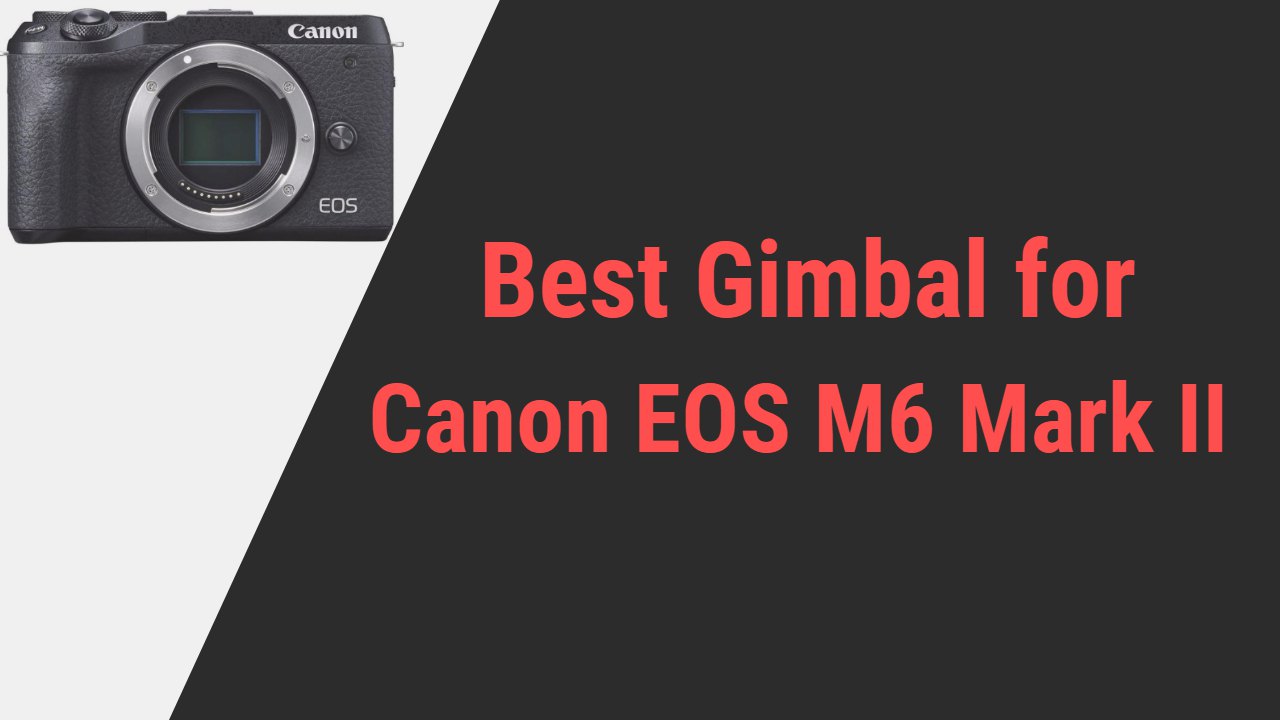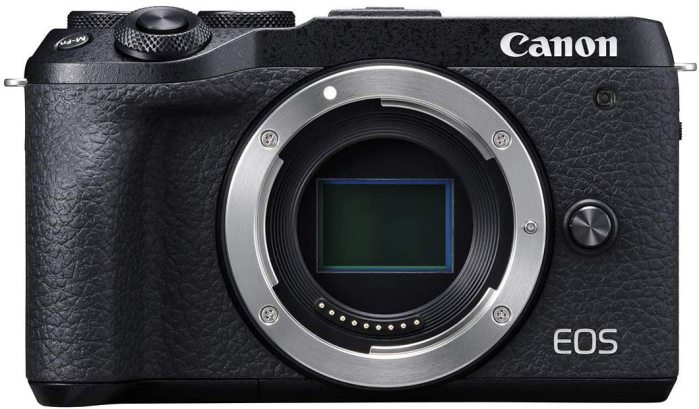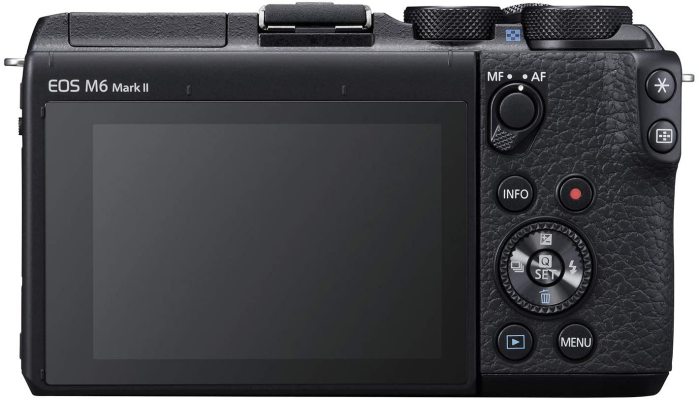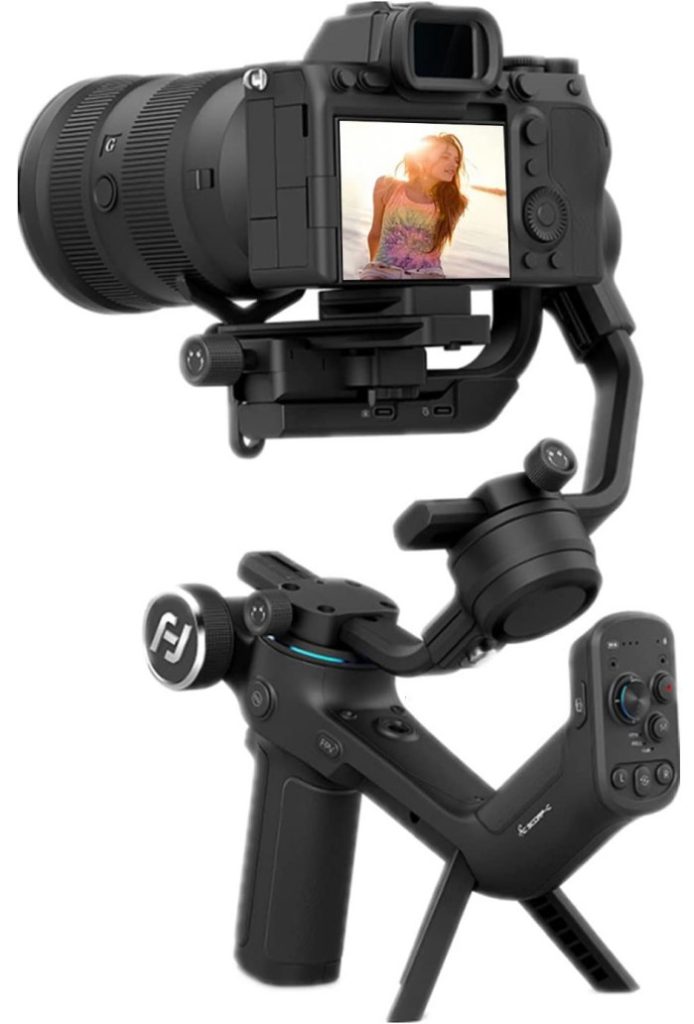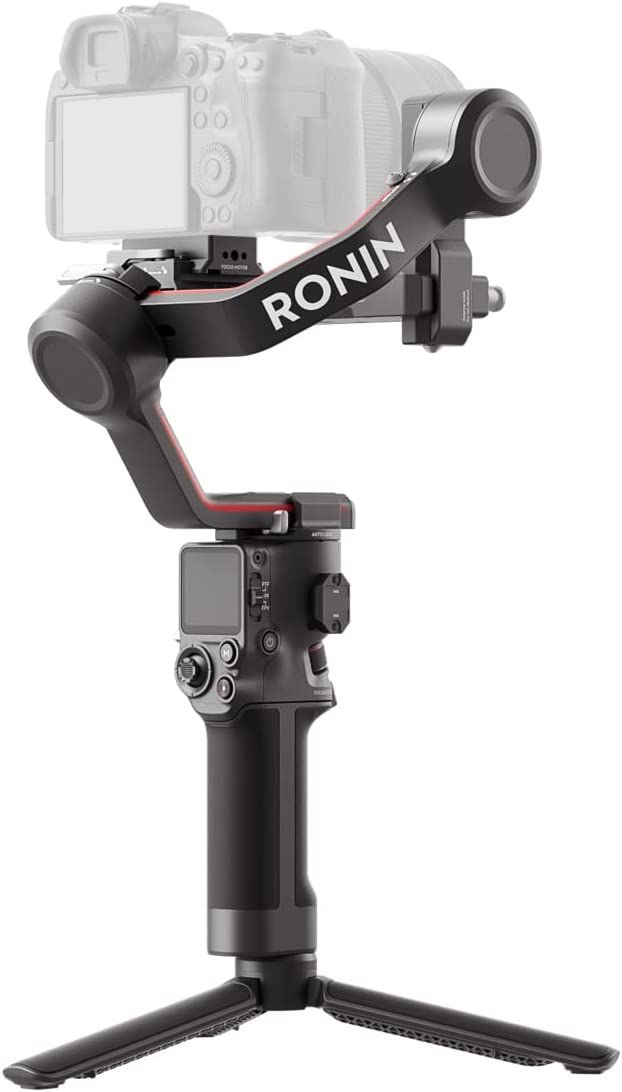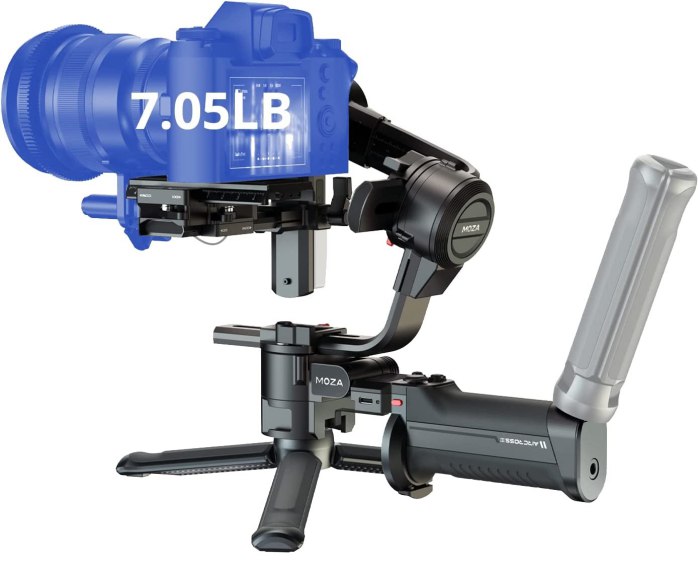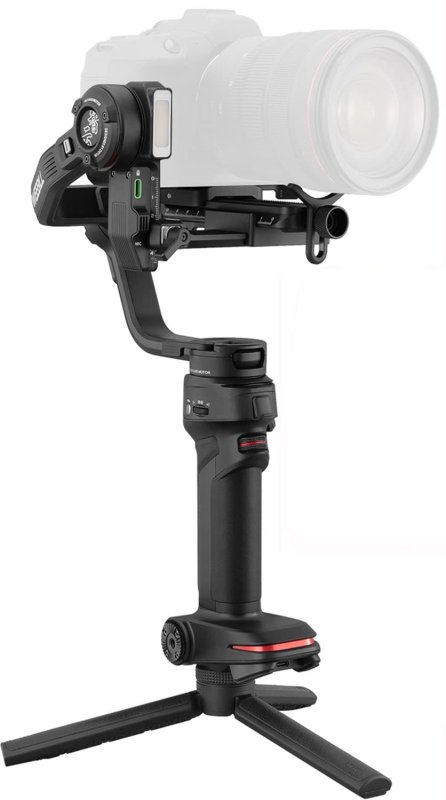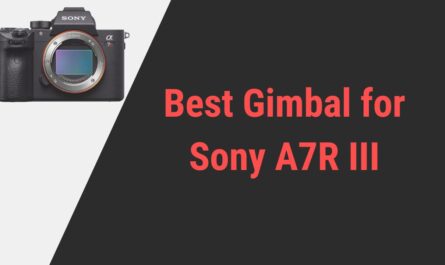Among Canon Other creations, Canon EOS M6 Mark II advanced camera is the most loved one by beginners as well as professional filmmakers.
The major reason behind this is the gimbal is an excellent option to frame some majestical-looking shots with the highest resolution and other amazing features. However, there is a way to perfection; you can do the same with the EOS M6 Mark II photography by finding the right pair of gimbals.
A gimbal is an additional tool, but theoretically, it’s a camera support system that ensures the professionalism of your shot. The gimbals are the right companion for those bumpy and shaky path shooting because they compensate for the micromovement caught in the frame, assuring stable and enhanced quality footage.
Considering all the competency and urgency, I have gone deep looking into the matter of the best gimbal for the EOS M6 Mark II camera.
Canon EOS M6 Mark II
Note:
All the gimbals mentioned here are tested with Canon EOS M6 Mark II and work perfectly fine.
| FeiyuTech SCORP-C (Best Overall)

|
| DJI RS 3 (Most High-end & Comes with Advanced Features)
     |
| MOZA AirCross 3
     |
| Zhiyun Weebill 3
     |
Varying the functions, creativity, convenience, and design, I have noted down a few masterpieces of gimbal that ideally suits the M6 Mark II camera.
You just need to take a nice long view and make your choice accordingly. Just a friendly reminder always picks the gimbal that suits your camera needs and budget, and do not fall for luxury and glam.
Go for it now!
Best Gimbal for Canon EOS M6 Mark II
1. DJI RS 3


So, I am going to start with one of the best; The DJI RS 3. The gimbal consumes tremendous potential and versatility factor, one that procures the finest stabilization for every picture you frame. Let’s have a look over its enticing abilities.
Gimbal Feature-
Payload– 6.6 Pounds
Weight– 2.4 pounds
Battery– 12 hours
Why DJI RS 3 is best for EOS Mark M6 II?
For the major reason, The blind trust over DJI RS 3 greatest stability. The gimbal is literally the all-rounder. It’s been configured with some heavenly upgraded algorithm to shoot balanced images, as the M6 Mark II can only grant stabilization in video.
The DJI RS 3 is empowered to shoot different creative motions, which is a win-win for the 32-megapixel resolution EOS M6 Mark II. The Gimbal’s highest payload of 6.6 pounds is enough to carry a 408-gram weighted M6 Mark II quite effortlessly.
Major Functions-
Let’s start with the easy accessibility; the best part of the gimbal is it supports easy calibration. With the help of a dual-layered quick-release plate, the camera’s mounting on the gimbal became so fast and convenient.
On top of easy calibration, the gimbal supports the automated axis lock, one that unlocks the gimbal creativity horizon by locking the axis and expanding it automatically to catch the trickiest angle.
The gimbal supports a 6.6 maximum payload capacity to carry the weight of additional accessories.
Next comes the Stabilization quality; as I said, the gimbal is mastered with the upgraded third-generation RS stabilization algorithm; This allows the quality stabilizing throughout the managing low-angle shot and running scenario.
With the increased motor torque, one can now get a super smooth result.
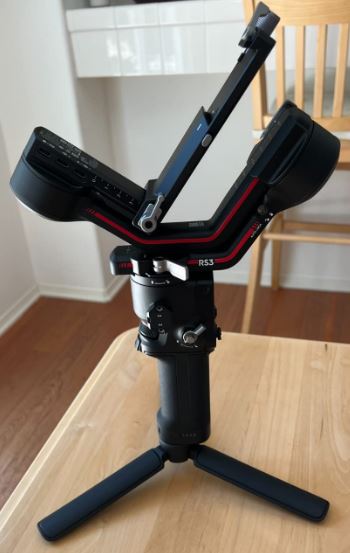

The gimbal is made easiest with user-friendly controls; The gimbal supports both wireless shutter controls and physical integrated control. The whole operation and control can be managed on the smartphone through the Ronin official application or the virtual joystick.
The gimbal also allows the integration of a RavenEye Image transmitter, which offers the Live Feed vision onto the mobile phone under a certain distance.
This gets better with the wide vision supported by the gimbal and the gimbal has a 1.8-inch OLED touchscreen panel with an 80% larger display.
When we talk about physical control, let’s count on the fine-tuning knob one that approximately sets the value according to the mounted object identifying adequate camera position.
Other than that, the simple slider lets you switch the shooting mode, while the front dial allows zooming and focus.
The gem of DJI, RS 3, is redesigned to be the lightest and most comfortable, but that doesn’t affect the gimbal strength, for that matter. With the strongest configuration of industrial-graded material, the gimbal is the toughest to support the largest camera.
The gimbal encourages creativity at the peak, which is why it supports filming intelligent motion function modes, such as Dolly Zoom, Motion Lapse, Time tunnel, and panorama. Apart from that, you are free to shoot multiple follow modes to get what you want.
The photographer can enjoy creativity for the longest hour; the high-end battery is blessed for shooting continuously through the in-built Lithium-ion polymer (LiPo) battery empowered with 3000 mAh, enough to grant 21 hours of working.
The cartridge design of the gimbal makes things super comfy for swapping batteries, and it can be charged separately from the gimbal. With the Quickest charging possible, it would take less than 2.5 hours to charge quickly.
Pros
- One step balancing
- Improved Axis Lock
- Updated stabilization algorithm
- Large display sized 1.8 inches
- Enhance battery runtime
- Intelligent motion function shooting
- Easy, effortless controls
- Adequate payload
- Compact size and lightest weight
Cons
- Gimbal could use a little innovation.
- The fluctuation with heavyweight could use improvement.
2. FeiyuTech SCORP-C
Moving on, we have Another piece of perfection from the design house of FeiyuTech, The brand who have been giving quality products for years.
FeiyuTech SCORP C is an upgraded high-end camera stabilizer that has a unique stabilization mechanism, intuitive controls and wonderful intelligence attached with a pretty decent price tag.
This is the major reason I have picked the gimbal in the first place; it’s like getting innovative treats of balancing without breaking the bank so that it can be brought by the person exploring their hobbies.
Gimbal Feature-
Payload– 5.5 pounds
Weight– 2.7 pounds
Battery– 13 hours
Why FeiyuTech SCORP C is best for EOS Mark M6 II?
Usually, gimbals are considered for stabilization purposes, but this Feiyu SCORP C is something that promises much more than that; This gimbal conquers quality filmmaking by granting you a different creativity horizon.
The gimbal is entangled with easy controls and handling, making the whole shooting operation easiest at pie. I prefer this exceptional gimbal for the EOS M6 Mark II because of its ability to carry a maximum payload, as well as the different creative angles and shooting modes it allows. Other than that price is also not much of a deal with this gimbal.
Major Functions
The gimbal supports easy mounting, from tripod to any other accessories; the gimbal uses three 1.4-inch to 20-inch threads, and the almighty Arca Compatibility makes things easiest as pie.
Above which, the Quick release plate keeps the frequent rebalancing trouble farthest away.
To complement the whole effortless mounting function, the gimbal’s configured with an effective motor. This motor uses the Autotune feature and adjusts the weight approximately accordingly to the weight of the camera or any mounted object.
The gimbal also allows the pairing of other additional accessories; it’s been blessed with a maximum payload of 5.5 pounds, And from my personal experience, I think that’s enough to support multiple accessories.
The gimbal comes with a sturdy design and ergonomic structuring considered to be its predecessor. The gimbal is tough enough to support the heaviest and largest camera due to its strong build, but the weight is at least 2.7 pounds.
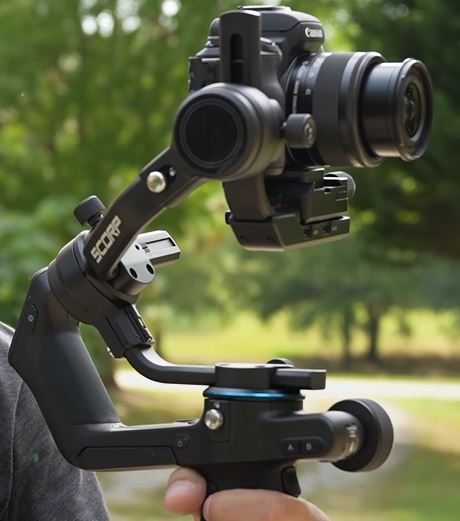

The SCORP C is popular for its convenient design, but there is something more that can’t be ignored, control. The gimbal comes with the most straightforward control. For starters, the gimbal has customizable buttons to control the gimbal functions and parameters.
While all the basic controls can be operated and modified via the smartphone application through the wireless support mechanism, then there is the normal magic ring that helps a lot and the dials that can be personalized accordingly to quickly transition to the preset position.
The gimbal supports the inception mode, one that makes things more innovative for the user, not just that this inception mode can be switched with just a single tap.
The same goes for the portrait-to-landscape mode switching; you can just toggle between shooting orientations.
The gimbal allows exploring creativity, as it supports shooting different modes, the trickiest angle, and other motion function modes. Some of the modes SCORP C gimbal expertise in are Time Lapse, Panorama, and track.
The gimbal comes with the in-built Lithium-ion Battery, which is empowered with 2500 mAh power; the battery is destined with the longest operation intention, which signifies 13 hours of a longer period of filming within a single charge.
Once the fully charged battery loses its power, it would take less than 1.6 hours to get the juice filled up using the quickest charging mechanism avoiding the inconvenience of letting you sit idle.
Pros
- Auto-tune and camera positioning
- Creative shooting modes
- Effortless Portrait to landscape switching
- Improved Inception mode
- Customizable control dials
- Smartphone control and monitor
- Enhance battery runtime
- Compact and lightest weight
- Budget-friendly tag
Cons
- OLED Panel improvement
- Intellectual should be better
3. Zhiyun Weebill 3
Moving on, I have this extra-circular Weebill 3 here, the top-notch camera stabilizer known for its improved design and enhanced comfortability; now, what else could one ask?
This extra powerful and innovative Weebill 3 gimbal is highly recommended because of its comfortable handling and structure. The sophisticated design, complemented by easy ergonomics, makes this gimbal your next run-and-gun option for a professional photoshoot.
Compatible with a wide list of cameras, this Zhiyun’s master creation qualifies as the best fit for EOS M6 Mark II camera.
Zhiyun Weebill 3 Feature-
Payload– Not Specified
Weight– 2.4 pounds
Battery– 21 hours
Why Weebill 3 is best for EOS Mark M6 II?
I preferred the design at first because one thing I was sure about during my experience with the Weebill 3, there was wide space for comfort. EOS M6 Mark II, with a weight of 408 grams, is not much of a deal for the gimbal.
And the gimbal’s upgraded stabilization algorithm is complemented by the camera’s in-built digital image stabilization, which works only in video.
Also, the extended gimbal power offers a strong backup to the camera battery, and you won’t be needed to sit idle during the filming, Which is why I very much adore this masterpiece.
Major Functions
Let’s talk infrastructure because that’s where the Weebill 3 expertise is specified. The gimbal comes with an improved design and sturdier structure, one that grants rigid support while holding the camera. The gimbal improved Sling 2.0 structure design is vividly shaped in L-shape.
This allows the gimbal to stand on its own on a flat surface, saving your precious money and effort on an additional tripod. Apart from that, the gimbal body is exceptionally compact and super lightest weight, just at the figure of 2.4 pounds.
However, that’s not it; the best part is the gimbal is considered highly ergonomic; this is because of the additional involvement of an extendable handle that allows it to cover the trickiest angle.
While the Additional wrist rest support gives you ease to rest your hand during the longest hour of filming.
The gimbal serves as a hot shot of quality stabilization through the Optimized stabilization algorithm. This is all doing to the compact yet mighty powerful motor that works through the dynamic shot only to adjust the balance.
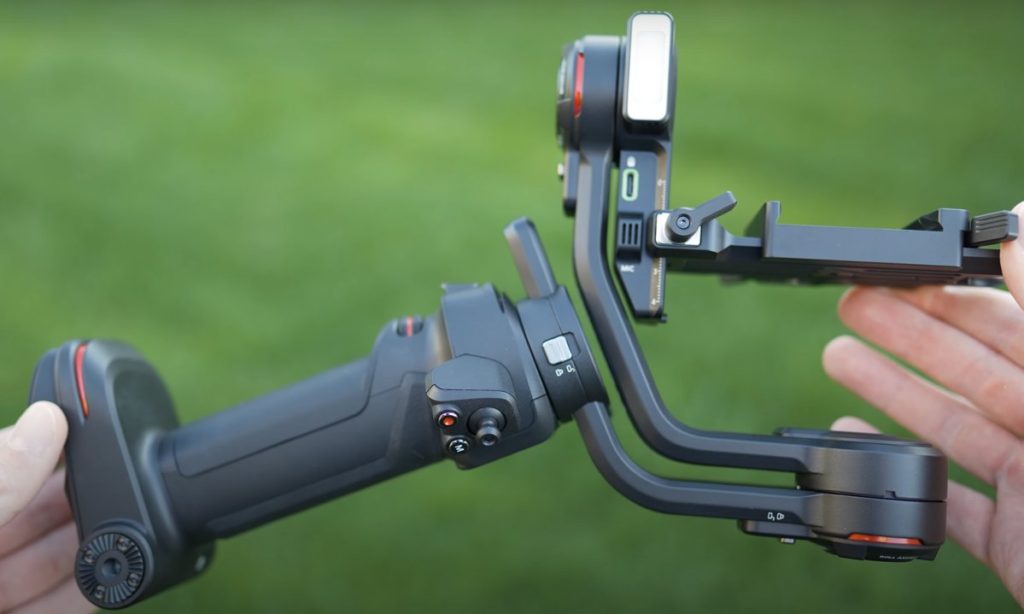

The gimbal is adapted to the easiest and most effortless control; It uses the simplest trigger button that can be customizable for switching shooting modes and the wheel controls for the camera parameters adjustment.
Other than that, it can be connected to the smartphone via the Zhiyun official application or through Wi-Fi or Bluetooth technology. On top of everything, it has an 0.96 inch OLED touchscreen that grants you a quick peak of operation and shooting.
Like the effortless controls, the gimbal comes with easy mounting; the situating, sliding, and locking mechanism works with the complimentary benefits of an easy Quick release system.
This whole strategy gets implemented via the Dual Quick release plates. Above that, a magnetic wrench embedded is used to mount and secure the camera.
Complimenting the image quality, the gimbal supports a very distinctive feature of fill-up lights. This in-built light consists of 1000 lumens of brightness, whose primary purpose is to enhance the image quality.
The brightness and color temperature can both be adjusted to make things better in enhancing the quality.
And additionally, the gimbal also has an in-built microphone whose main function is noise canceling, Hi-Fi, and cardioid recording throughout the longest filming hour. This microphone is configured in the 3.5mm general audio port design in the gimbal body.
And last but not least, the gimbal is configured with a lithium-ion battery charged to 2600 mAh power. These three 18650 Li batteries have been assigned to grant 21 hours of longest period working within a single charge.
Once the battery goes off, the gimbal can be recharged within less than 2 hours only to be active on stabilizing.
Pros
- No requirement for the tripod
- Improved sling 2.0 structuring
- In-built light with filter kit
- Longest battery runtime of 21 hours
- In-built Microphone port
- Magnetic wrench mount and quick release
- Easy and customizable controls
- Effortless wheel and trigger control
- Affordable price tag
- Additional Wrist rest supporting ergonomic
Cons
- Payload should be specified
- The stabilization algorithm can be improved
4. MOZA AirCross 3
Coming to last, apart from the all-experienced brand, I have a soft corner for another outstanding brand Moza that’s also quite a star in the photography world. I am listing here Moza’s masterpiece, Aircross 3 gimbal.
Aircross 3 is known for its infinite and reliable creativity; A decent payload and easy handling are the basics; this gimbal has been consumed with level-up innovation and AI that can leave you stunned with the out-of-the-world filming experience.
Let’s have a look over its significant top-notch factors.
MOZA AirCross 3 Feature-
Payload– 7 pounds
Weight – 2.9 pounds
Battery– 19 hours
Why MOZA AirCross 3 is best for EOS Mark M6 II?
Moza Aircross 3 is an all-rounder; the gimbal literally has everything. The adequate payload, reliable durability, and vital trust to take good care of expensive cameras like EOS Mark M6 II.
Single-handed gimbal with a professional approach to capturing buttery smooth flow coordinates with the M6 II 32-megapixel resolution and cook miraculously flawless imagery.
There are numerous advanced mounting strategies the gimbal uses to make sure your camera is secure and yet make your filming easy with convenience. The creative modes, angles, and other smart intelligence suits well for the EOS Mark M6 II
Major Functions –
Let’s start with the design; the gimbal comes with a never seen attractive look and improved design; However, the main motto of the gimbal is to provide ease and comfortability, which is why it supports foldable structuring.
The gimbal can be folded down to the size of A4 size paper with this mechanism to provide ease.
However, do not let the compact size confuse you with the gimbal’s durability. The body of the stabilizer is composed of the strongest composite material and strengthened metal, providing a tactile feel, almost giving the thrill of extension of your arm; the least weight of 2.9 pounds is an additional charm.
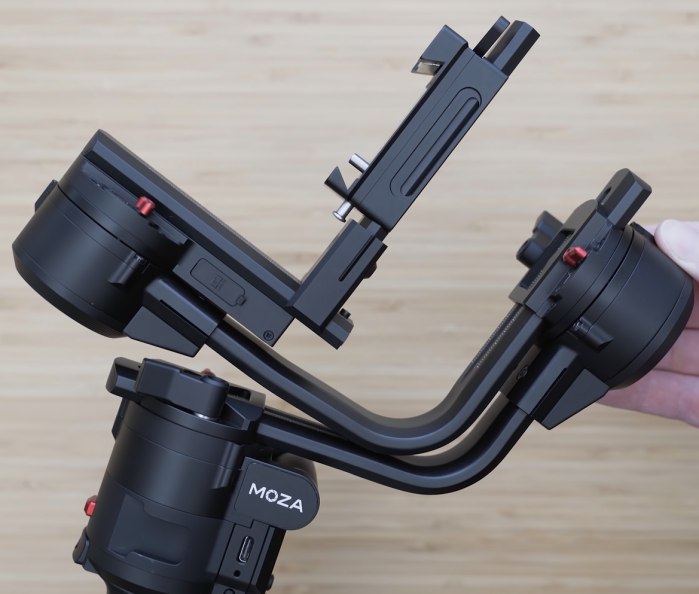

The gimbal is a master in providing stabilization to dynamic subjects. In the dominance, the gimbal’s ability to carry multiple accessories also comes along.
The gimbal includes 7 pounds of payload, which can be used to add other accessories in order to get a brilliant shot.
Above which, the Manual Position 2.0 major function is to manually pull and drag the camera to turn towards the shooting position and quickly switch when using follow mode. In contrast, the three-latch locking system is for simplifying the usage and for step-by-step balancing.
As in the complimentary, the gimbal uses the Deep Red algorithm, one that makes things better at attitude control and behavior prediction, all for providing a higher level of stability and control over shots.
The mounting was never a big deal in the Aircross 3 gimbal; two shoe mounts and three 1.4-inch to 20 threads are added for the additional mounting.
The gimbal is trained to perform magic in creative shooting modes; it allows shooting four follow modes, including the smart FPV modes and the exceptional Sport Modes 2.0, all of which feature the all-lock follow with the five adjustable speed control.
Except that, you can also perform quite a miracle following the intelligent motion function shooting modes such as time-lapse capture and multiple follow modes.
The complimentary inception mode will ease and enhance the efficiency of shooting, while the Sport Gear mode allows catching live action.
Switching between these modes is easiest as pie, such as the switchable dial between the portrait and landscape modes, the single button for Photo shutter or recording, or the easy control dial for camera setting parameters.
Auto Tuning AI of the motor ensures the camera position by assigning approximate values according to the mounted object.
The gimbal is configured with a smart and potent motor that has the motto of consuming less power and granting more creativity. It also has an updated OLED display panel with an advanced, Accurate, and responsive User Interface and graphic sidebar.
There isn’t a shortage of power; the in-built Lithium-ion battery inside the gimbal is designed with 3500 mAh power, enough to grant the longest 19 hours of filmmaking operation within a single charge.
However, the best part is the battery can be recharged really quickly, within 1.4 hours, with the help of two USB Type C ports fast charging.
Pros
- Longest battery runtime of 19 hours
- Better motor and stabilization strategy
- Deep Red algorithm working
- Compact body with foldable designing
- Upgraded Manual Position 2.0
- Updated OLED display and better UI
- Three-latch locking system
- Auto Tuning AI motor
- Creative shooting modes and easy control
- Higher payload and least weight
- Affordable price tag
Cons
- Image quality could be improved
Why do you need a gimbal for EOS M6 Mark II?
“Mastercard of stabilization perfection”, which is generally named a Gimbal, is none other than the type of pivoted support system that rotates its axis of a single object that is mounted on top in order to shoot different angles without approaching any jittering or unprofessionalism.
In short, it’s the wonderfully curated advanced tool that manages the shakiness effect and produces some flawlessly clear and sharp shots.
This whole high-end operation is performed with the advanced motors and sensor presented in the gimbal; they do the work of stabilizing while you tilt, pan, or roll the camera.
The gimbal is an utterly essential tool required for shooting cinematic shots. Besides stabilization, the gimbal is also responsible for other benefits like enhancement in maneuverability.
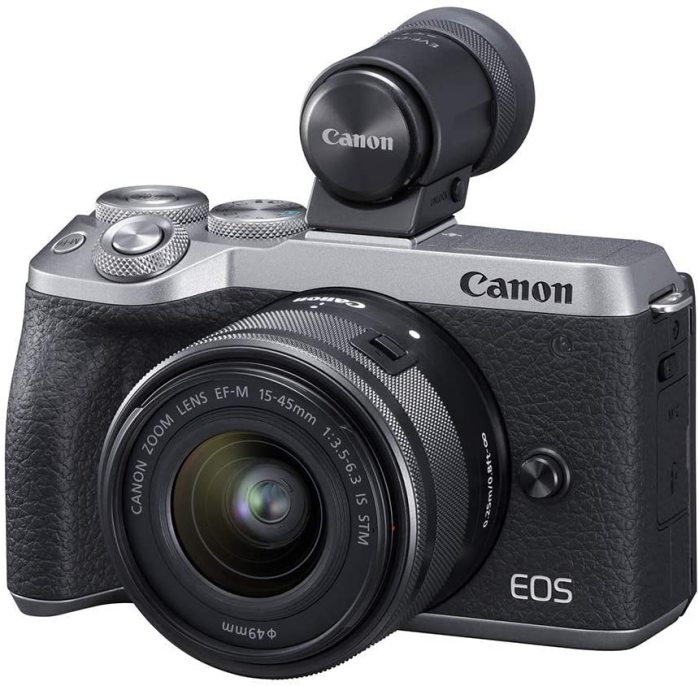

Canon EOS M6 Mark II, as you might know, comes with digital in-built image stabilization, but the limitation of that camera-built stabilization is it works for video only; so what about still photography?
To give charm to the EOS M6 Mark II photography, a rightful pairing of the gimbal is prominently necessary. Let’s see why exactly the gimbal is bliss for EOS M6 Mark II
- They are trained to get the trickiest angle shot
- They are essential for the videographer (for catching live-action)
- They allow the comfortable and more secure grip of your M6 Mark II
- They are brilliant at shooting aerial shots with Mark II
- They allow filming for a long time without any hand or back strain
- They are extremely easy to assemble, install and use
- They are lightest weighted and easy to carry during travel
- They allow shooting in different directions saving effort and time
- They enhance the image quality and professionalism.
- They provide peace of mind with a user-friendly interface.
What are some shooting moves to try using the gimbal?
Gimbals are one of the highly professional tools we are talking about; the one that can assure you top-notch artistic footage without requiring much effort.
They usually are configured with some high-level stabilization algorithm to perform such action, but you know you can always practice different perspectives to achieve more creativity in the photography world.
This is why there are some creative gimbal moves you can try if you want to explore and embrace more creativity in the filming world.
Follow– The simple and yet popular try follow shot by simply closing in on the subject. You can try the classic pull-out by walking backward in front of the subject or the classic push by moving towards the subject.
Reveal– the most creative move which requires moving your gimbal from side to side and revealing the subject from behind any prop or obstruction, giving a dramatic look
Profile– Some simplicity is the gem, which is why to hold your gimbal stationary in your hand and capture the most static shot of the subject. This is the profile shot; you can try close-ups in this shooting mode.
Underslung– Do not underestimate the power of an underslung shot; always try one or two brilliant low-angle shots or either try push in or pull out by staying in underslung mode
Parallax– This never gets old, Keep the subject in the center and move your gimbal around in a circular manner subjected to 180 degrees or even 360 degrees to get the best orbit shot.
Drone– Crane shots are the best in Hollywood; try to explore the drone shot by raising the gimbal up high in the air to catch a better view of the subject up end high and simply rotate it or follow the subject.
Let’s look over the camera: Canon EOS M6 Mark II.
Canon is one of the most famous names in the world of photography; The finest and oldest name in the industry has curated another piece of perfection.
With the pure mingling of resolution and comfortability, Canon EOS M6 Mark II has a sleek body APS-C mirrorless camera with the glorious purpose of granting enhanced image clarity and sharpness.
Wrapped with an advanced image processor and sensor, the camera associate performs miraculous creativity in the photography world. The camera came out of the house at the end of August 28 in the year 2019
Flooded with the high-technology, upgrades, and intellectual, the mirrorless camera M6 Mark II has range-wide features that suit multimedia applications.
Talking about the same, the gimbal combined with outstanding low light filming, better focusing with phase detection, and the highest speed performance.
Along with the advancement, the camera is destined to shoot comfortably with its sophisticated outer structure. Configuring with the advanced power backup and environmental sealing, the camera is associated with the least price tag of $849 for the body only.
If you want to get the combo with Canon 15-45mm lens, the price rises to $1099, and if you get the camera with Canon 18-150mm lens, the price rises to $1349.
Amazing features of Canon EOS M6 Mark II
Featuring an advanced processor and innovation, the EOS M6 Mark II is potent to perform creative magic, but how? Let’s have a look over its flawless features.
Shooting– The camera is designed with the Digic 8 processor and CMOS Sensor with APS-C Sized. The sensor grants a 33-megapixel resolution to shooting quality shots.
Filming– The camera is trained to film stunning video footage at up to ultra-HD 4K at the highest 30p speed. Regular Full HD at the 120p and HD at the 60p
Recording– The camera supports internal recording and uses the in-built stereo microphone for quality enhancement. The camera limits the recording to up to 29 minutes and 59 seconds.
Focus– The camera works finest with both Auto and manual focusing modes, indulging the continuous-servo AF, Manual Focus, and Single-servo AF with -5 to +18 sensitivity. The camera also has 5481 phase-detection points.
ISO– The camera is designed with better illumination for which it holds the Auto ISO, the ISO with the sensitivity range of ISO 100 to ISO 25600 for the photo, which can be extended to ISO 51200 and ISO 100 to ISO 12800 for the video, which can be extended to ISO 25600.
Display– the camera lacks live streaming through the viewfinder, but it has a 180-degree tilting LCD panel that is entirely finger-touch-oriented. Sized at 3 inches, the screen comes with a 1040 K dot resolution.
Storage– With the means to carry heavy storage, the camera includes a single slot for a memory card. The slot supports the SD or SDHC, or SDXC card formatted in the UHS-II bus format.
Interface– other than that, the camera also has one micro-HDMI output, one 3.5 mm stereo microphone input, and a USB C charging port interface for connectivity.
Shutter-The camera comes with both a mechanical focal plane shutter and an electronic shutter. The mechanical shutter has a 1/4000 to 30-second speed, while the electronic shutter has 1/1600 to 30 seconds. At the same time, the continuous shooting has 14 fps.
Connectivity– Speaking of connectivity, the camera works with upgraded Bluetooth and Wi-Fi technology to establish the connection for data transferring and stuff.
Flash– the camera comes with the in-built Flash for better exposure; this flash uses the Auto and red eye reduction technique and has a 1/200 second maximum sync speed. There is also an eTTL dedicated port for the external flash.
Stabilization– Since the camera is quite the master in filmmaking, the brand indulged in digital image stabilization in the camera that works to compensate for the micromovement for the video only.
Lens– The camera is designed with the EF M lens configuration, and since it is the M series edition, The camera can only work with the Canon EF-M lenses. Any other lenses can be used using any supporting adapter.
Power– The camera is designed with the powerful LP-E17 lithium-ion battery with the strongest composition; the battery can be recharged anytime using the simplest charging port.
Runtime– The lithium-ion battery is charged with 1040 mAh power that grants approximately 305 constant shots within a single charge. Once the battery gets drained, it takes less time to recharge.
Designing– The mirrorless camera is associated with a peculiar rangefinder-style body composed of a magnesium Alloy and polycarbonate mixture, assuring strength and durability.
Weight– However, considering the comfortability factor, the camera comes with a heavy ergonomic and easy comfortability factor with the least 408-gram weight as a compliment.
Frequently Asked Questions (FAQs)
Q. Is Canon EOS M6 Mark II worth investing in?
Definitely, It’s the most precious jewel of Canon design house. Mingled with the highest resolution and better convenience factor, this EOS M6 Mark II qualifies as being the best mirrorless camera with a Sleek and strong body potent to shoot 32.5-megapixel resolution images and UHD 4K videos.
The better processor and Auto ISO manages the image crispness, and the upgraded focusing with the smoothness and cinematic effect. With digital stabilization, the camera makes the videography exciting while the ergonomic least weighted body of the camera assures comfort while filming.
The high-performer with outstanding works for a longer period with the strongest Li battery while the price came wallet-friendly, so yeah totally worth it
Q. Would a camera with auto stabilization need a gimbal?
Well, I think so; here is the thing with auto stabilization, it works to make your video makes smoother and shake-free to make it delightfully pleasing to the audience, and it also liberates the hassle of carrying a gimbal around, but the auto stabilization quality is not much of reliable source of balance.
This means the auto stabilization accuracy somewhere differs, and this definitely throws a negative impact on the picture. Also, sometimes the auto stabilization in order to stabilize the shot blur out the details in the picture, and it’s something you cannot afford to accept in the line of professional filming; so yeah gimbal is definitely needed for not only quality stabilization but also for smart stabilizing.
Q. Which brand gimbal is best for EOS M6 Mark II?
You might have noticed I have mentioned quite a lot of times that the market Is flooded with advanced and differently functional gimbals from different brands.
But how would you know which brand is suitable for your gimbal? So there are few reputed brands that cooked p best gimbals in the market, such as the DJI Ronin; their creative competency served hot shots with a dose of reliability, while the Zhiyun Tech exposed something out of the world every time they launched any gimbal.
Some others, like the Moza, are also a handful in creating perfection with innovation and comfort, while the FeiyuTech made the most affordable one. You may pick any trustworthy item from the market.
Q. Are gimbals the best tool for filming?
A big yes, gimbal is designed with the purpose of providing perfection in filmmaking; Which is the major reason why professional vloggers and filmmakers are fond of this tool.
See, filmmaking is the trickiest part of photography; catching the live-moving subject on frame might sometimes leave blurriness, shaking, and jitter and all this trouble can be sabotaged by gimbal expertise without interfering with the quality.
Not just the stabilization gimbal plays a key part in making videography operations comfortable by carrying the camera weight for a longer period or also by acting as a battery backup during event filming for hours.
Final Words
You should have it clearly fit in mind that every gimbal with astonishingly pleasant function and versatility in the market will not be suitable for your camera.
There are certain factors that decide if one stabilizer will collaborate and cooperate with your EOS M6 Mark II.
Pairing the wrong gimbal might be hazardous to the image quality and the health of the camera itself, so it is utterly significant to keep your eye on every slight factor while buying one.
Cutting all the chaos of the market, I have tried making things simplest for you; I have listed the best and my personal favorites with you.
Even though I love all of them equally, let me clarify a little more for you, FeiyuTech SCORP C is the cheapest, most convenient, and user-friendly gimbal in the list, while weebill S is something that is rich in top-notch intelligence.
Personally, I think nothing can beat the professionalism of the DJI RS 2 gimbal, the high performer and advanced gimbal, but you can get the whole intellectual and function along with the decent price tag all within the Moza Aircross 3.
So, which one will it be? Let me know in the comment section below.
Also, Keep in touch for more helpful articles but till then Happy Filming!

